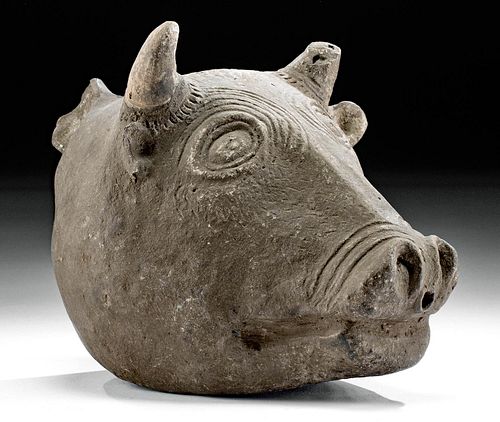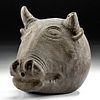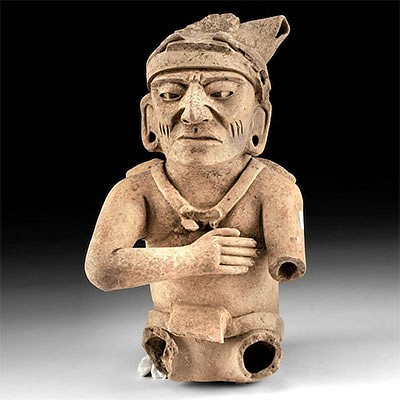Ancient Near Eastern Pottery Bull Rhyton, TL Tested
Lot 11
About Seller
Artemis Fine Arts
686 S Taylor Ave, Ste 106
Louisville, CO 80027
United States
Selling antiquities, ancient and ethnographic art online since 1993, Artemis Gallery specializes in Classical Antiquities (Egyptian, Greek, Roman, Near Eastern), Asian, Pre-Columbian, African / Tribal / Oceanographic art. Our extensive inventory includes pottery, stone, metal, wood, glass and textil...Read more
Categories
Estimate:
$1,800 - $2,500
Absentee vs Live bid
Two ways to bid:
- Leave a max absentee bid and the platform will bid on your behalf up to your maximum bid during the live auction.
- Bid live during the auction and your bids will be submitted real-time to the auctioneer.
Bid Increments
| Price | Bid Increment |
|---|---|
| $0 | $25 |
| $300 | $50 |
| $1,000 | $100 |
| $2,000 | $250 |
| $5,000 | $500 |
| $10,000 | $1,000 |
| $20,000 | $2,500 |
| $50,000 | $5,000 |
| $100,000 | $10,000 |
| $200,000 | $20,000 |
About Auction
By Artemis Fine Arts
Feb 3, 2022
Set Reminder
2022-02-03 10:00:00
2022-02-03 10:00:00
America/New_York
Bidsquare
Bidsquare : VARIETY SALE | Ancient, Asian, Ethnographic
https://www.bidsquare.com/auctions/artemis-gallery/variety-sale-ancient-asian-ethnographic-8833
Join us for our first sale of February with a spotlight on two fabulous collections, one from Lumberton, Texas, and the other from Whisnant Gallery in New Orleans. Artemis Fine Arts info@artemisgallery.com
Join us for our first sale of February with a spotlight on two fabulous collections, one from Lumberton, Texas, and the other from Whisnant Gallery in New Orleans. Artemis Fine Arts info@artemisgallery.com
- Lot Description
Ancient Near Eastern, Central Asia, or Egyptian, ca. 1600 to 1400 BCE. A beautiful hand-built rhyton or libation vase in the form of a bull head, replete with expressive features delineated in low to high relief, including large round eyes with creases above as if opening them wide, a prominent wrinkled snout with delineated nostrils and mouth, and pointy horns with ears below. A small opening in the mouth is for pouring liquid, and the back of the head has a larger opening that likely once has a flared rim or neck. The bull has a significant history in the ancient world, with representations from every culture, from the Minoans to the Egyptians, and to the Greeks and Romans - symbolizing virility, power, and strength. Size: 9" L x 5.5" W x 6.25" H (22.9 cm x 14 cm x 15.9 cm)
This piece has been tested using thermoluminescence (TL) analysis and has been found to be ancient and of the period stated. A full printed and bound report is available for $50 to the buyer. Please contact us to request.
Provenance: East Coast collection, New York Gallery, New York City, New York, USA, acquired before 2010
All items legal to buy/sell under U.S. Statute covering cultural patrimony Code 2600, CHAPTER 14, and are guaranteed to be as described or your money back.
A Certificate of Authenticity will accompany all winning bids.
PLEASE NOTE: Due to recent increases of shipments being seized by Australian & German customs (even for items with pre-UNESCO provenance), we will no longer ship most antiquities and ancient Chinese art to Australia & Germany. For categories of items that are acceptable to ship to Australia or Germany, please contact us directly or work with your local customs brokerage firm.
Display stands not described as included/custom in the item description are for photography purposes only and will not be included with the item upon shipping.
#137675Losses to large opening behind the bull's horns. Losses to tip of horn. Losses to ear and surface abrasions throughout. TL hole on the interior rim of the broken spout and second TL hole on the underside of the snout / lower jaw. Great details and light mineral and earthen deposits.Condition
- Shipping Info
-
All shipping is handled in-house for your convenience. Your invoice from Artemis Gallery will include shipping calculation instructions. If in doubt, please inquire BEFORE bidding for estimated shipping costs for individual items.
-
- Buyer's Premium



 EUR
EUR CAD
CAD AUD
AUD GBP
GBP MXN
MXN HKD
HKD CNY
CNY MYR
MYR SEK
SEK SGD
SGD CHF
CHF THB
THB














